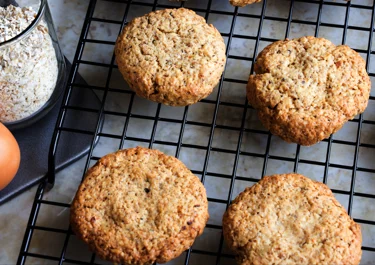
Oat cookies

Instructions
Questions about oat cookies
Making a batch of warm, homemade oat cookies just got simpler. Are you curious about using different ingredients or how to get that perfect chewy texture? Our FAQ section guides you through the steps of oat cookie perfection. Find answers to common questions below and take your baking skills to the next level for delicious treats every time.
Ingredients
Butter (room temperature) | 150 g |
|---|---|
Caster sugar | 120 g |
Rolled oats | 150 g |
Wheat flour | 90 g |
Salt | 1 pinch |
Baking soda | ½ tsp |
Explore a world of flavours with oat cookie add-ins
Make your oat cookies uniquely yours by mixing in a variety of flavourful add-ins. Mix ½ cup of your favourite baking chips – chocolate, butterscotch or toffee are popular choices – into the batter to add rich flavour. For a more traditional taste, blend in a handful of raisins, dried cranberries, cherries or even apricots. If you enjoy a bit of crunch, add ½ cup of chopped nuts like walnuts or pecans. For a warm and inviting hint of spice, mix in a teaspoon of ground cardamom with a dash of cinnamon. Get creative and use these options as inspiration to discover your very own signature combination.
Mastering flour measurement for oat cookies
To get the perfect texture for oat cookies, measure flour with care. The spoon-and-level technique prevents dense cookies. First, fluff the flour with a fork to add air. Then spoon the flour into the measuring cup until it's slightly heaped. Use a straight-edged knife to level off the excess. This method ensures you use the exact right amount of flour for cookies that are chewy inside and crisp around the edges.
Freeze the dough for later use
To make sure you are never without your favourite oat cookie snack, keep a batch of dough in the freezer. Start by shaping the dough into balls and place them on a baking sheet in the refrigerator. Once they harden, move them to a freezer-friendly container or bag. You can keep the dough in the fridge for up to 10 days or freezer for up to a month.
Ready to bake? Remove the dough from the fridge (thaw frozen dough at room temperature for about 15 minutes) and bake as normal. You can also freeze baked oat cookies by cooling them down and storing in an airtight container in the freezer for up to three months.
Monitor baking times for optimal texture
To get the perfect texture for your oat cookies, watch the oven closely as you approach the 8-minute mark. Aim for cookies with golden edges and a soft centre. This timing gives your cookies a crisp edge and a chewy middle, as our recipe intends. Your oven and the cookie size might shift your baking time by a minute or two, but it's safer to check often (without opening the oven door) to avoid overbaking. After baking, let the cookies cool on the tray for a few minutes to firm up, then move them to a wire rack to cool completely.
What kind of butter should I use?
Your choice of butter – salted or unsalted – will change the flavour of your oat cookies. If you are using salted butter, consider leaving out the pinch of salt in our recipe. Unsalted butter lets you adjust the taste, creating a perfect balance of sweet and savoury.
You can use alternatives like plant-based shortening or coconut oil instead of butter. Shortening will result in a crispier cookie while coconut oil can introduce a slight tropical taste. Use the same amount of these substitutes as you would butter, but you might need to adjust the quantities slightly to get the texture just right.
Chill and rest your dough
While you don't have to chill your dough before baking, it will give your oat cookies a better texture. Chilled dough lets the oats soak up moisture, which means your cookies will have chewier middles and crispier edges once they're baked. If you have time, rest the dough for a few hours (up to four days) for an even better texture.
Choose the right oats
Old-fashioned rolled oats are the top choice for oat cookies, as they give a chewy texture and rich flavour. Steer clear of instant oats, which soften too fast and might cause your cookies to spread out too much. Quick oats also fall short in providing the desired chewiness. If you're looking to add a unique, grainy texture, a small amount of steel-cut oats can do the trick. Just remember to soak them first to ensure they soften and bake evenly in your cookies.
Prevent your oat cookies from spreading too much
To ensure your oat cookies don't spread too much and stay chewy, space the dough balls well on the baking sheet to prevent them from merging into each other. An overmixed dough also tends to spread more so be sure to mix just enough to combine the ingredients. For even-sized cookies, use an ice cream scoop and line your baking tray with baking paper to prevent them from sticking and spreading unevenly. These steps will help your oat cookies keep their ideal shape and texture.
Level up your oat cookie presentation
Serving oat cookies in an appealing way can significantly boost their enjoyment. Place the cookies on a rustic platter or an attractive ceramic dish to highlight their comforting, wholesome appeal. For variety, add a few granola bars, carrot cake muffins or spelt cookies. This presentation not only offers a snack for every tastebud, it also looks good and brings a sense of warmth and nostalgia.
Choosing the right drink to accompany your oat cookies can take the taste experience to a new level. A warm cup of milk is a timeless choice, offering a creamy texture against the cookies. For a stronger option, pair your snack with an aromatic cardamom coffee, cool caramel Frappuccino or classic latte. These drinks' rich aromas complement the oat cookies' subtle flavours, perfect for a cozy break.
To enhance the cookies' look and taste, sprinkle them with powdered sugar. This adds sweetness and a refined appearance. Drizzling melted chocolate over the cookies can make them even more indulgent. The chocolate's richness and smoothness pair well with the hearty oats, making each bite feel like a treat.
If you want to add colour and a fresh twist, garnish the cookies with citrus zest or edible flowers. These details can turn a simple snack into a festive treat and add a refreshing flavour note.










